Laurel tree: reproduction and care at home
Laurel is a subtropical tree or bush. There are several types of this plant. Naturally, they grow in the Mediterranean and in the south of the Krasnodar Territory.
Content:
- Laurel tree: description, types
- Reproduction of laurel
- Laurel care
- Crown formation and transplant
- Disease and pest control
Laurel tree: description, types
Laurel belongs to the Lavrov family of the same name. Types of laurel:
- Azores is distinguished by its large decorative ovoid leaves. It blooms in May with light yellow flowers.
- Camphor, so named because of the high content of camphor in the leaves and stems. The crown of the plant is wide, branched. The leaves give off a spicy scent. The leaves are lanceolate, with small dots throughout the field. The flowers are yellow-green.
- Noble, the leaves of which are used for food. It is a perennial evergreen tree or shrub. Under natural conditions, he lives up to 100 years. During this time, its height reaches 10 m. In the apartment, it grows up to 3 m. Its stems are covered with leathery leaves about 8 cm long. In spring, the noble laurel blooms with small yellow flowers. When grown at home, flowering is rare, after reaching 5 years of age. Laurel fruits are small.
Reproduction of laurel
Laurel can be propagated by layering, cuttings and seeds:
- The easiest way to get a new plant is from cuttings. They can appear on their own. If this does not happen, a laurel branch is added in the spring, watering the place where rooting takes place. The next spring, a new plant is planted in a separate pot, after cutting off the layering from the main tree.
- It is necessary to propagate laurel by seeds in the fall. To do this, take a pot, lay drainage on the bottom, then sprinkle it with soil. Watering. Cover the pot with plastic wrap. They are waiting for shoots to appear.
- It is faster to get a young plant from the cutting of a young plant. To do this, take non-lignified cuttings with 2-3 buds or leaves. Prepare the soil in the same way as for growing from seeds, but cover the soil with a layer of sand on top. The length of the cutting is up to 8 cm. The cuttings are immersed so that the lower edge is immersed in the sand by 1 cm. The soil for laurel is prepared by mixing humus, sod, old foliage. Peat and sand are added. If there are no such components, you can plant the laurel in a universal soil purchased at a flower shop.
Good neighbors for laurel in the room will be rosemary, lavender... They will create a beautiful corner, in addition, they will have a positive effect on the well-being of the owners. After all, phytoncides that secrete laurel leaves contribute to this.
Laurel care
Although laurel belongs to subtropical plants, it can even withstand temperatures as low as 5 degrees below zero. But this only applies to old sheets. Young, spring ones can freeze even with slight frosts. Therefore, do not rush to take the tree out into the fresh air. It winters best at a temperature of 12-15 ° C. In the summer, he needs warmth. The optimum will be 25-28 degrees. Laurel does not like sudden changes in temperature.
When choosing a place for laurel, take into account that it feels best in a well-lit place. But direct sunlight on the leaves should be avoided.It also grows in the shade, but in this case the branches will stretch out and lose their decorative effect.
In an apartment or office, in no case should a laurel be placed near a radiator or other heating devices.
Laurel loves fresh air. Therefore, the room where it grows must be regularly ventilated. And in summer, it is better to take the plant out to the balcony or in the garden, setting it in partial shade. Laurel is not afraid of drafts. It tolerates heat well, but grows worse at the same time.
Like all subtropical plants, laurel grows well in high humidity. To provide the tree with a comfortable environment, the leaves are regularly sprayed with water. It should be soft and not cold. Once a month, you can have a shower by covering the potting soil with plastic wrap.
How to water the plant:
- In the summer, you can ensure a suitable humidity by placing a pot with a tree in a large pallet, at the bottom of which pebbles and moss are laid. A little water is poured into it. If possible, you can spray the plant with a spray bottle several times a day.
- It is watered abundantly in the warm season, but not poured, so as not to get stagnant water in the pot. In hot weather, it is better to water in the morning and evening. Do not water during the day so as not to get water on the leaves. This can cause sunburn on them.
- You can take tap water for irrigation, then only after it has settled well. Its temperature should be higher than in the room.
- In winter, the number of waterings should be reduced, and the interval between them should be increased. But it is also impossible to overdry the soil, the plant may die. At this time, the laurel is not watered. Periodically, you can wipe the leaves with a damp cloth.
For the laurel to be strong and beautiful, it needs to be fed. During the period of active growth, this is done once a month. It is easier to use complex fertilizers. You can alternate organic and mineral.
Crown formation and transplant
Root system laurel does not like to be disturbed. But the tree is growing and needs replanting. Therefore, it is better to do it by transshipment. So the root system moves from one flowerpot to another along with a lump of earth, practically without damage.
Young laurel trees are replanted approximately every 2 years.
If it does not grow very actively, and there is enough space in the pot for the roots, you can do this even less often. Plants 5 years old and older are transplanted after 4 years. A new pot is taken 3 cm wider than the previous one. A drainage layer is laid on the bottom. It will ensure a timely outflow of water and protect the root system from stagnant water.
You can take almost any soil, even ordinary garden soil. Add some humus. If the soil is clayey, sand is poured to increase moisture permeability. If it is sandy, add a little clay. It will help to retain the required amount of moisture. Water the laurel abundantly, wait until the water is absorbed, and the soil will lag behind the walls of the pot. Carefully remove the tree, laying it on its side on a mat or oilcloth. Examine the root system. If there are damaged roots, they are carefully cut, sprinkle the cut with crushed charcoal. If possible, take out drainage stones entwined with roots.
The crown of laurel lends itself well to shaping and pruning:
- It is carried out in early spring so that young shoots have time to grow. Lignified twigs are shortened by 20 cm. From the buds located below the cut site, new shoots will appear, the bush will become curly and voluminous.
- By trimming, you can give the laurel the desired shape: a ball, a cone, a pyramid or another curly one.
- To form a crown of an unusual shape, you need to start from a young age, cut off more often, but little by little.
- Some growers advise pruning laurel at the end of summer. Leave young shoots, which will grow in spring.
Disease and pest control
The main pest of laurel is the scale insect. She can be seen on the sticky traces of her life.If you look closely at the trunk, you can see small, round parasites that sit firmly near the cuttings of the leaves or on the underside of the leaves. The leaves themselves become shiny in appearance. You can fight the shield by chemical and mechanical methods. Chemical is the treatment of leaves and trunk insecticides... You can get rid of in this way faster, but you cannot use the leaves for food after that.
To remove the scabbards by hand, remove them with a damp cotton swab. This is a longer process. Processing must be carried out until the scabbards are not. But then you need to control it for some time, because young individuals may appear. Laurel at home is susceptible to certain diseases, fungal or viral. A black sooty bloom on the underside of the leaves may be a sign of damage. To combat them, biological preparations are used, for example, "Gamair".
If the conditions for growing laurel are violated, it reacts with a change in appearance:
- If the indoor air is too dry, the leaves begin to curl.
- If they dry, you need to lower the room temperature.
The same symptoms may indicate high air density. Lower the temperature or move the plant to a cool place. Cover with a plastic bag. This will help increase the humidity. Soon the young leaves will begin to grow back.
If the air temperature in the room is too high in winter, the laurel can completely shed its leaves.
In this case, you need to move it to a cooler room. If you put a plastic bag on it, the leaves will recover very quickly. The laurel leaves are almost the same as those sold in the store. But experts do not advise using it for food. It may happen that when grown in a greenhouse or in a flower shop, it was treated with chemicals that are harmful to the human body. And in modern apartments and offices, it can absorb hazardous substances. In addition, the leaves may lose their aroma as a result of drying at home.
More information can be found in the video:



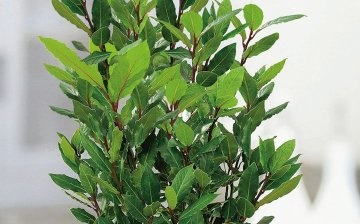











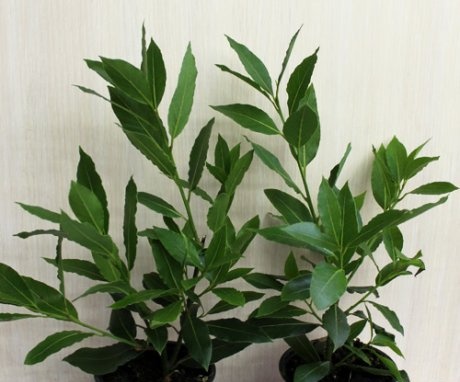
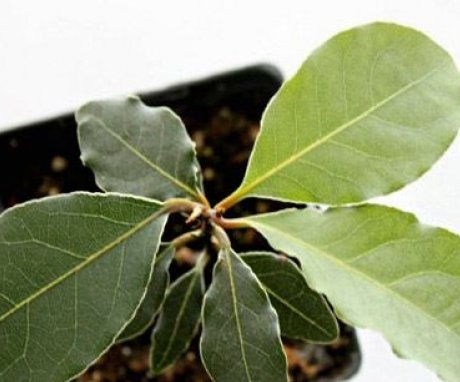
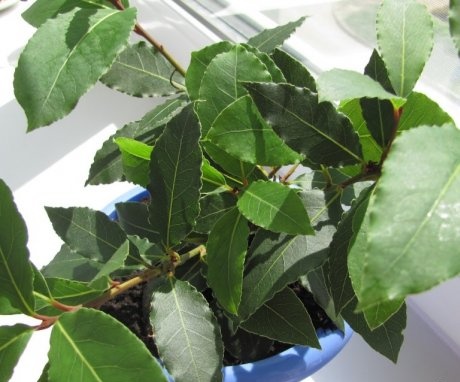

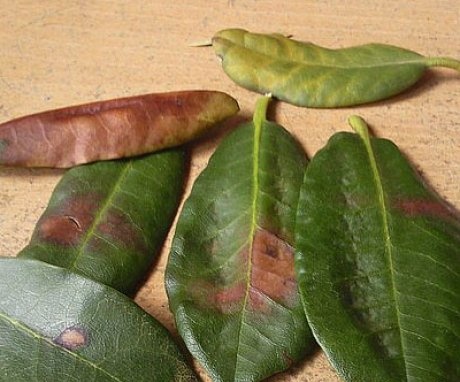
I didn't know that laurel can be grown in a room. I saw this evergreen shrub in the Crimea. I need to try to grow it at home, though I don’t know where to get the planting material?
I bought such a tree, but did not know that it was laurel. Somehow I did not feel the smell. Now I will know that this flower can be used not only for beauty, but also for practical purposes. By the way, I have it perfectly settled down and is absolutely unpretentious.
I was also interested in the laurel tree, I think we should go to the store and take a closer look at it. None of the acquaintances have such a bush growing to ask for a sprout.